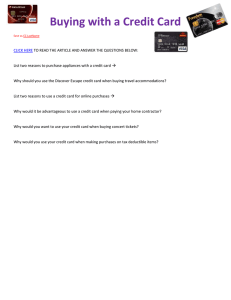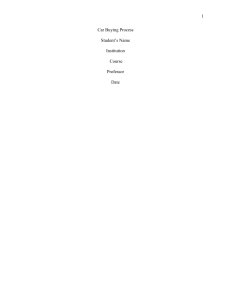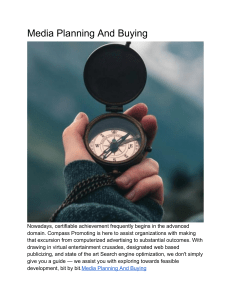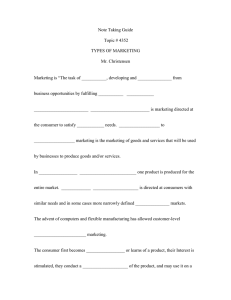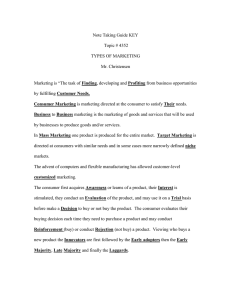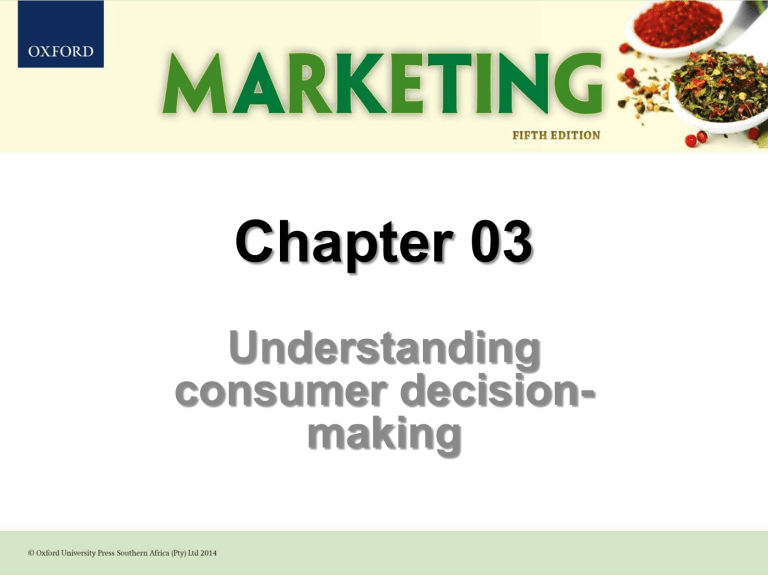
Chapter 03 Understanding consumer decisionmaking Chapter outline • The importance of understanding consumer behaviour • A model of consumer behaviour • The consumer decision-making process • Types of consumer buying decisions and consumer involvement • Individual factors influencing consumer buying decisions • Social factors influencing consumer buying decisions Chapter outline • The influence of the purchase situation on buying decisions • Buying ‘new-to-the-world’ products • Buying behaviour and technology Understanding consumer behaviour (CB) Consumer behaviour = how consumers make purchase decisions and how they use and dispose of the purchased goods or services. Marketing managers base their decisions and marketing strategies on this Model of CB • individual factors • social factors • purchase situation All three are external variables that influence the consumer’s decisionmaking process (internal process) Model of CB INDIVIDUAL FACTORS •Perception •Motivation •Learning •Values, beliefs, attitudes •Personality, selfconcept, lifestyle (Fig 3.1) SOCIAL FACTORS •Culture •Reference groups •Opinion leaders •Family •Social class BUYING SITUATION •Purchase reason •Purchase time •Physical surroundings CONSUMER DECISION-MAKING PROCESS (Fig 3.2) TO BUY OR NOT TO BUY Consumer decision-making process (Fig 3.2) Problem recognition Individual and social factors and buying situation Information search Evaluation of alternatives Purchase Postpurchase behaviour Consumer decision-making process Step 1: Problem recognition • Individual and social factors and buying situation • • • consumer realises he/she has an unfulfilled need/want discrepancy between actual state and desired state Triggered when consumer is exposed to stimulus occurs when: ‒ experience problems with current product ‒ see newer/superior product Consumer decision-making process Step 2: Information search Individual and social factors and buying situation Internal search • memory / experience External search • non marketing-controlled • marketing-controlled Consumer decision-making process Individual and social factors and buying situation Step 2: Information search Extent of external search depends on: • perceived risk • knowledge • prior experience • level of interest Consumer decision-making process Step 3: Evaluation of alternatives and purchase Individual and social factors and buying situation Evoked set • Brand consumer seriously considers • Consumers develops decision-making criteria • Depend on attributes Customer decides which product to buy or not to buy at all Consumer decision-making process Step 4: Post-purchase behaviour Individual and social factors and buying situation How well expectations are met determines whether consumer is satisfied or not Cognitive dissonance = inconsistency between values/opinions and behaviour that lead to an inner tension or anxiety Types of consumer buying decisions and consumer involvement Routine response behaviour Low involvement Limited decisionmaking Extensive decisionmaking High involvement • Level of involvement • Time to make decision • Cost of product/service • Degree of information search • Number of alternatives considered Consumer involvement Consumer involvement = the amount of time and effort a buyer invests in the search, evaluation, and decision processes of CB • Frequently purchased, low cost goods have low involvement, routine response behaviour and limited decision-making e.g. grocery buyers spend 10seconds in front of the grocery shelf for a specific item e.g. Cereal • Engage in extensive decision-making when buying an unfamiliar, expensive product or infrequently bought item. Use criteria to evaluate options, spend more time collecting information e.g. Home, car, overseas holiday Factors determining the level of consumer involvement • Previous experience • Interest • Perceived risk of negative consequences • Situation • Social visibility Marketing implications of consumer involvement • Marketing strategy depends on level of involvement •High involvement products: extensive communication •Low involvement products: customers may not recognise wants until they are in a shop, so in-store advertising is vital •Buyer behaviour is influenced by three variables: Individual factors Social factors Prevailing purchase situation Individual factors influencing consumer buying decisions • Perception • Motivation • Learning • Values, beliefs, attitudes • Personality, self-concept, lifestyle Individual factor: Perception Perception = process by which we select, organise, and interpret stimuli into a meaningful and coherent picture Stimulus = any input affecting 5 senses • Selective exposure • Selective distortion • Selective retention • Just-noticeable difference Marketing implications of perception • Must recognise the influence of cues on consumer perception • Identify attributes consumers want • Design cues that signal these attributes to customers • Use of: Price Colour Warranties Individual factor: Motivation Fig 3.3: Maslow’s hierarchy of needs Self-actualisation needs Esteem needs Social needs Safety needs Physiological needs Individual factor: Learning Learning = the process that creates changes in behaviour through experience and practice Types of learning Experiential learning Reinforcement and repetition enhance learning Conceptual learning Individual factor: Learning Related learning concepts Reinforcement Repetition Stimulus generalisation Stimulus discrimination Product differentiation Individual factors: Values, beliefs, attitudes Value = an enduring belief that a specific mode of conduct is personally or socially preferable to another mode of conduct Belief = an organised pattern of knowledge that an individual holds as true about his or her world Attitude = a learned tendency to respond consistently toward a given object Individual factors: Values, beliefs, attitudes Changing beliefs about attributes Changing importance of beliefs Adding new beliefs Individual factors: Personality, self-concept, lifestyle Personality = a way of organising and grouping the consistencies of an individual’s reactions to situations Self-concept = how consumers perceive themselves (ideal versus real self-image) Lifestyle = a mode of living as identified by a person’s activities, interests and opinions – psychographics examine and categorise lifestyles Social factors influencing consumer buying decisions Culture Reference groups Opinion leaders Family Social class Social factor: Culture Culture = the set of values, norms and attitudes that shape behaviour, as well as the products of that behaviour as they are transmitted from one generation to the next • Culture is dynamic – adapts to needs and environments • Cultural values in SA Social factor: Subculture Subculture = a homogenous group of people who share elements of the overall culture as well as cultural elements unique to their own group • Subcultures in SA ‘Black market’ Protestant, WASP, Jewish, Catholic, Muslim Home languages Lifestyle choices Social factor: Reference group Reference group = all the formal and informal groups that influence the buying behaviour of an individual Bases of social power Information Legitimate power power Referent Expert power power Social factor: Reference groups Primary Small, informal group Direct Face to face Secondary Large, formal group Types of reference groups Aspirational Desired to be a member Indirect Non-aspirational Avoids membership Social factor: Opinion leaders Opinion leaders: important target market influence others often first to try new products are typically activists tend to be self-indulgent Social factor: Family and family life cycle Decision-making roles in the family Initiator Influencer Decision-maker Purchaser User Social factor: Family and family life cycle Family life-cycle = a series of stages through which consumers’ attitudes and behavioural tendencies evolve, through maturity, experience and changing income and status Social factor: Social class Social class = a group of people who are considered nearly equal in status or community esteem, who regularly socialise among themselves both formally and informally and who share behavioural norms • Upper class • Middle class • Working class • Lower class Purchase situation’s influence on consumer buying decisions • Purchase reason affects buying • Time affects buying • Physical surroundings affect buying Buying new products Six steps in adoption process Awareness Interest Evaluation Trial Decision Confirmation Buying behaviour and technology • Technology breeding new type of consumer • Don Dillon: ‘Information can now be transferred and turned into knowledge instantly from everywhere. There are few competitive technologies, tools, product insights or knowledge areas in London or New York that are not available in Buenos Aires or Bangkok. Because so many companies have access to this technology, the speed at which they need to compete has dramatically increased. But the central motivation of the purchasing model remains the same. Consumers are drawn to value. This has always been a value based on cost, quality and convenience. But technology has driven the perception of value to embrace new dimensions. Consumers want to buy now. We’ve never before dealt with such powerful consumers. And because they have more control, they expect more personal attention.’
